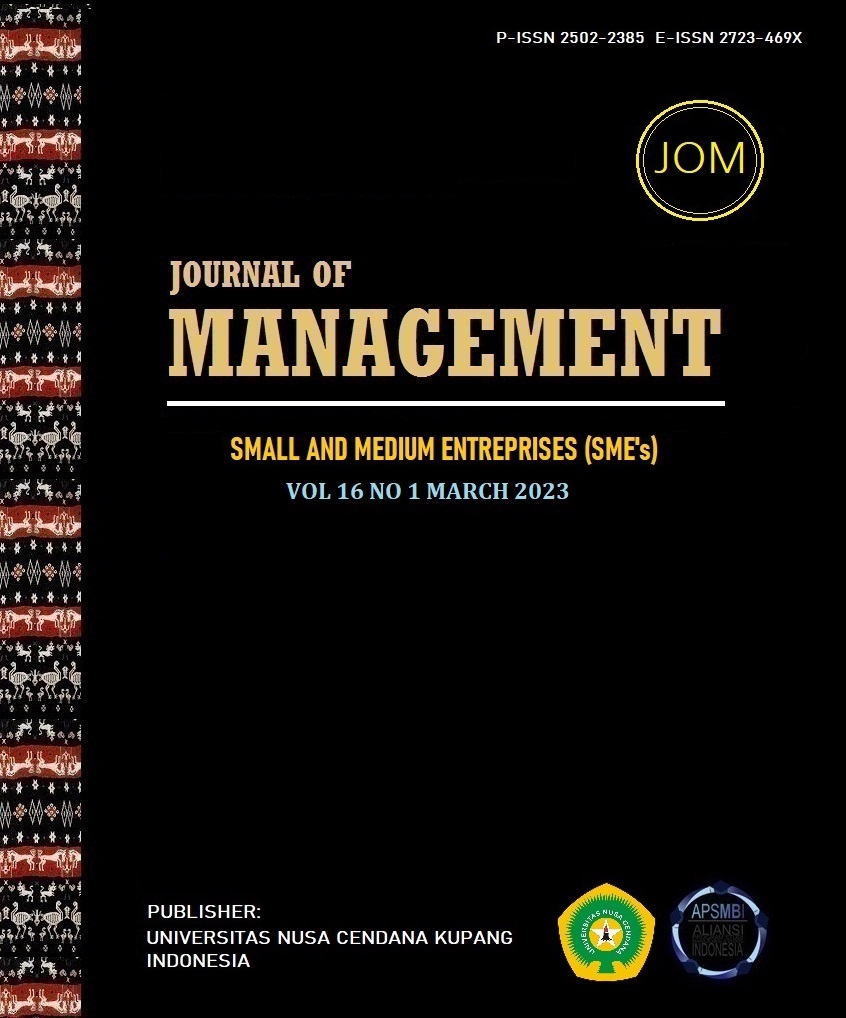PENGARUH TRUST TERHADAP ONLINE REPURCHASE INTENTION DENGAN E-SATISFACTION SEBAGAI VARIABEL MEDIASI: STUDI PADA GENERASI MILENIAL PENGGUNA TOKOPEDIA
Abstract
This study aims to examine the influence of trust to repurchase intention with e-satisfaction as a mediating variable. This study uses an online survey designed to collect data from the millennial generation who have made at least two purchases at Tokopedia. A total of 113 responses were considered valid, for data analysis using the SEM-PLS approach. Overall, the findings show that there is no direct significant relationship between trust and repurchase intention. In an indirect relationship, trust has a positive and significant effect on repurchase intention through e-satisfaction. This finding reveals that trust is an important factor in creating e-satisfaction with online shopping and consequently increases the repurchase intention at Tokopedia.
Keywords: Trust; E-satisfaction; Repurchase Intention
Downloads
References
Chiu, C. M., Wang, E. T. G., Fang, Y. H., & Huang, H. Y. (2014). Understanding customers’ repeat purchase intentions in B2C e-commerce: The roles of utilitarian value, hedonic value and perceived risk. Information Systems Journal, 24(1), 85–114. https://doi.org/10.1111/j.1365-2575.2012.00407.x
Chou, S., Chen, C.-W., & Lin, J.-Y. (2015). Female online shoppers Examining the mediating roles of e-satisfaction and e-trust on e-loyalty development. 25(4), 542–561. https://doi.org/10.1108/IntR-01-2014-0006
Dirusso, D. J., Mudambi, S. M., & Schuff, D. (2011). Pricing strategy & practice Determinants of prices in an online marketplace. Journal of Product & Brand Management, 20(5), 420–428. https://doi.org/10.1108/10610421111157946
Foster, B. (2017). Pengaruh Pengalaman Belanja Online Produk Fashion terhadap Kepuasan dan Niat Beli Ulang Pelanggan Zalora serta Berrybenka. Kontigensi, 5(1), 68–76.
Hair, Joe F., Ringle, C. M., & Sarstedt, M. (2011). PLS-SEM: Indeed a Silver Bullet. Journal of Marketing Theory and Practice, 19(2), 139–152. https://doi.org/10.2753/MTP1069-6679190202
Hair, Joseph F. (2017). A primer on partial least squares structural equation modeling (PLS-SEM). In SAGE Publications, Inc. (Second Edi). SAGE Publications, Inc.
Kim, H. W., & Gupta, S. (2009). A comparison of purchase decision calculus between potential and repeat customers of an online store. Decision Support Systems, 47(4), 477–487. https://doi.org/10.1016/j.dss.2009.04.014
kontan.co.id. (2022). BI: Total Nilai Penjualan E-Commerce di 2021 Tercatat Rp 401 Triliun.
Made Purnami, N., & Nurcaya, N. (2015). PENGARUH E-TRUST, PERCEIVED USEFULNESS DAN E-SATISFACTION TERHADAP ONLINE REPURCHASE INTENTION. Seminar Nasional Sains Dan Teknologi (Senastek).
Naim, M. F., & Lenka, U. (2018). Development and retention of Generation Y employees: a conceptual framework. Employee Relations, 40, 433–455. https://doi.org/10.1108/ER-09-2016-0172
Pavlou, P. A., & Gefen, D. (2004). Building effective online marketplaces with institution-based trust. Information Systems Research, 15(1), 37–59. https://doi.org/10.1287/isre.1040.0015
Saleem, M. A., Zahra, S., & Yaseen, A. (2017). Impact of service quality and trust on repurchase intentions – the case of Pakistan airline industry. Asia Pacific Journal of Marketing and Logistics, 29(5), 1136–1159. https://doi.org/10.1108/APJML-10-2016-0192
Sekaran, U., & Bougie, R. (2013). Research Methods for Business: A Skill-Building Approach (6th Edition (ed.); 6th Editio). Wiley.
Sharon, Al. (2015). Understanding the Millennial Generation. Journal of Financial Service Professionals, 69(6), 11–14.
Sirclo.com. (2022). 15 Marketplace di Indonesia yang Paling Banyak Pengunjungnya.
Tahun, R. A., Bunga, M., & Nyoko, A. E. L. (2018). Pengaruh Kepercayaan Dan Komitmen Terhadap Loyalitas Nasabah Pada Bank Perkreditan Rakyat Tanaoba Lais Manekat Kota Kupang. Journal of Management Small and Medium Enterprises (SMEs), 7(2), 147–165.
Trivedi, S. K., & Yadav, M. (2018). Predicting online repurchase intentions with e-Satisfaction as mediator: a study on Gen Y. VINE Journal of Information and Knowledge Management Systems, 48(3), 427–447.
Trivedi, S. K., & Yadav, M. (2020). Repurchase intentions in Y generation: mediation of trust and e-satisfaction. Marketing Intelligence & Planning, 38(4), 401–415. https://doi.org/10.1108/MIP-02-2019-0072
Tutar, H., Erdem, A. T., & Karademir, Ö. (2021). Moderator role of old and new Y generation differences in the effect of perceptions of self-efficiency on decision-making strategies Role of old and new Y generation. Management Research Review. https://doi.org/10.1108/MRR-01-2021-0026
Yuniarti, F., Arief, H. R., Meydia, H., & Oesman Yevis, M. (2022). Online retailers’ ethics and its effect on repurchase intention: The mediating role of perceived risk Online retailers’ ethics and its effect on repurchase intention: The mediating role of perceived risk PUBLIC INTEREST STATEMENT. https://doi.org/10.1080/23311975.2022.2051691

 Farisa Novita Puri(1*)
Farisa Novita Puri(1*)



